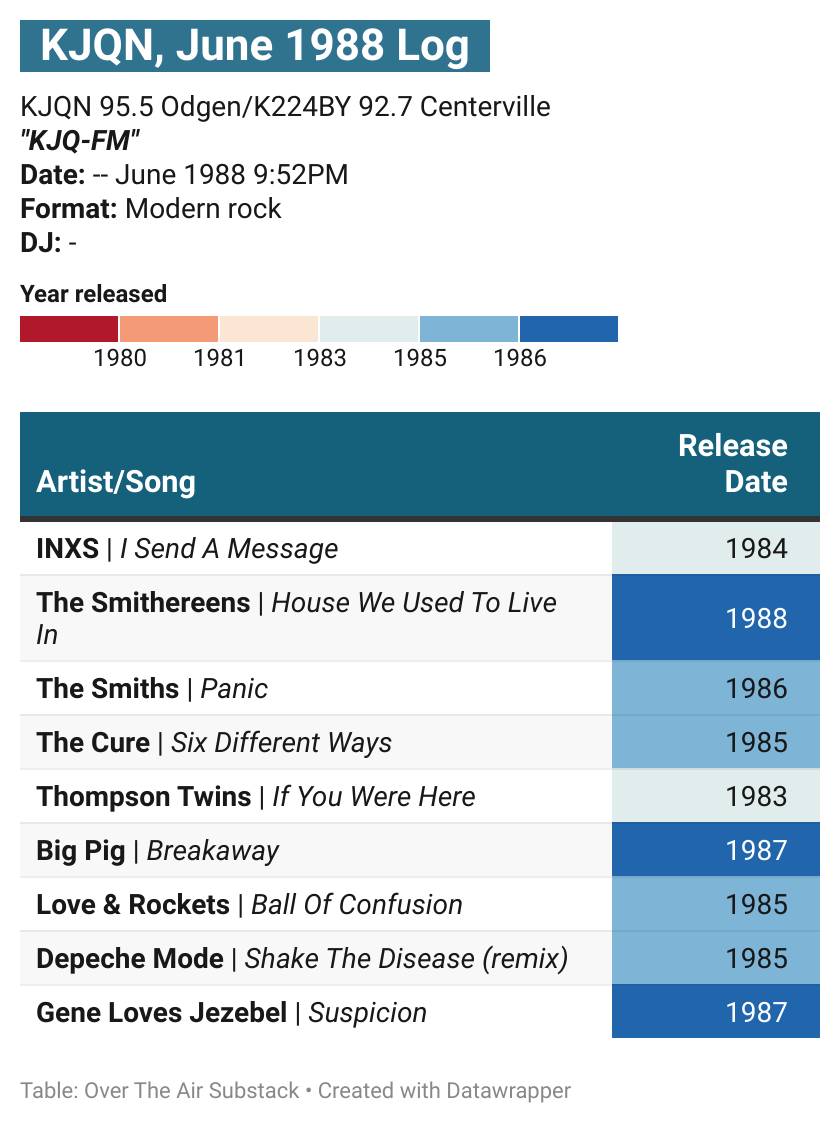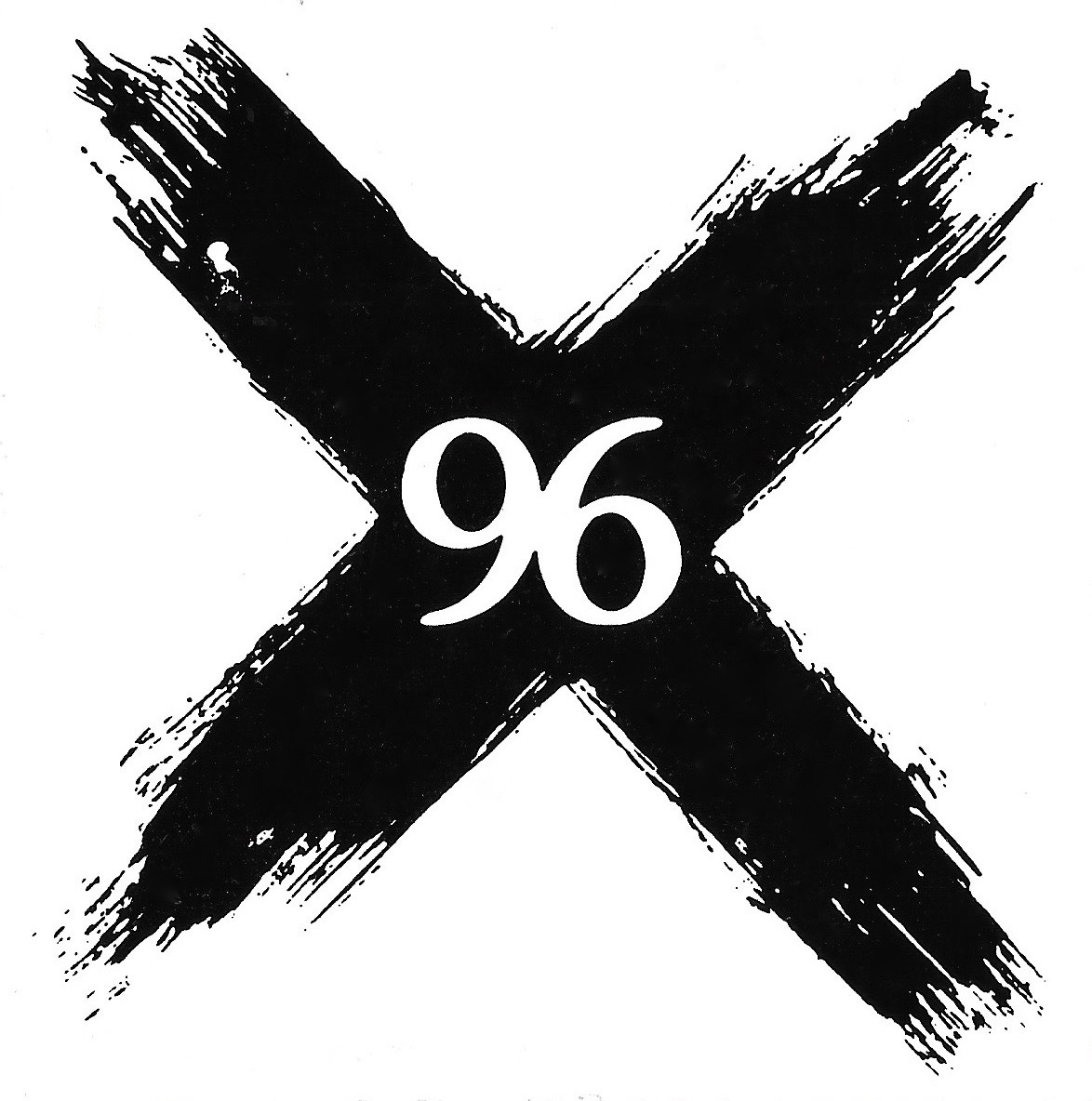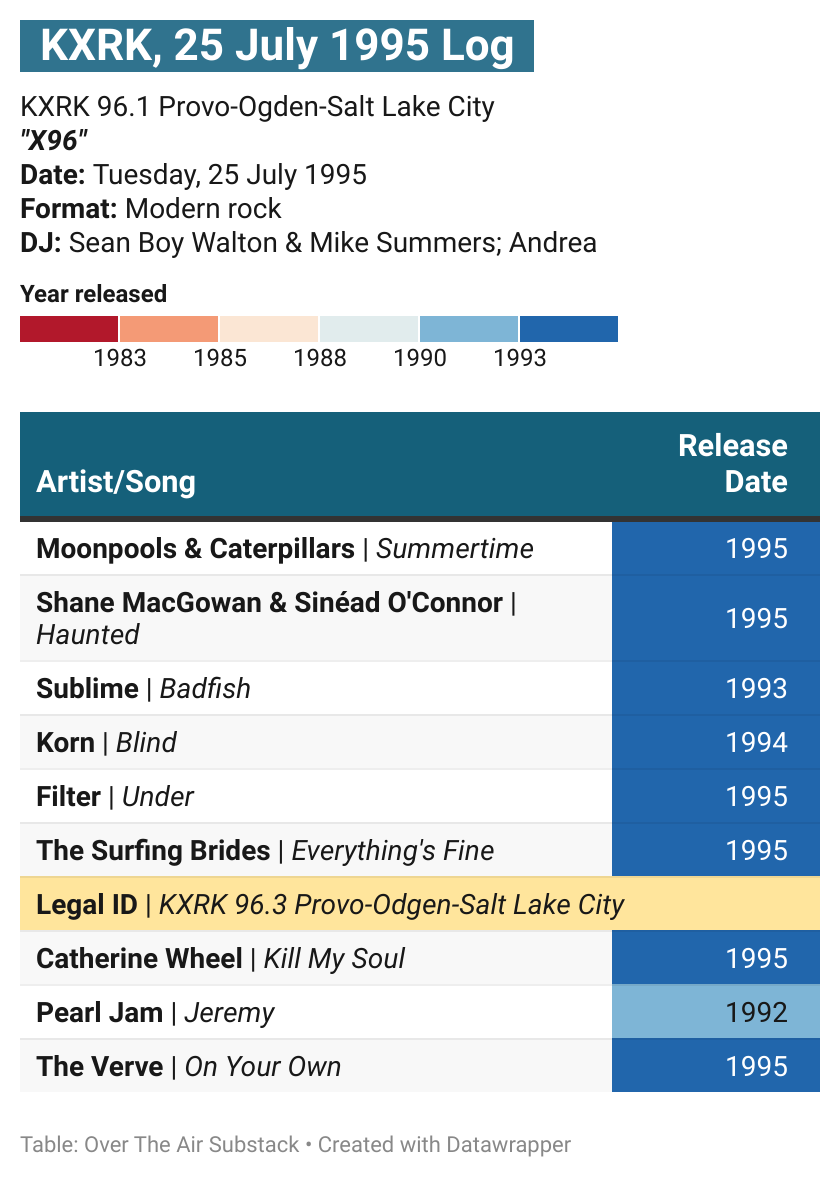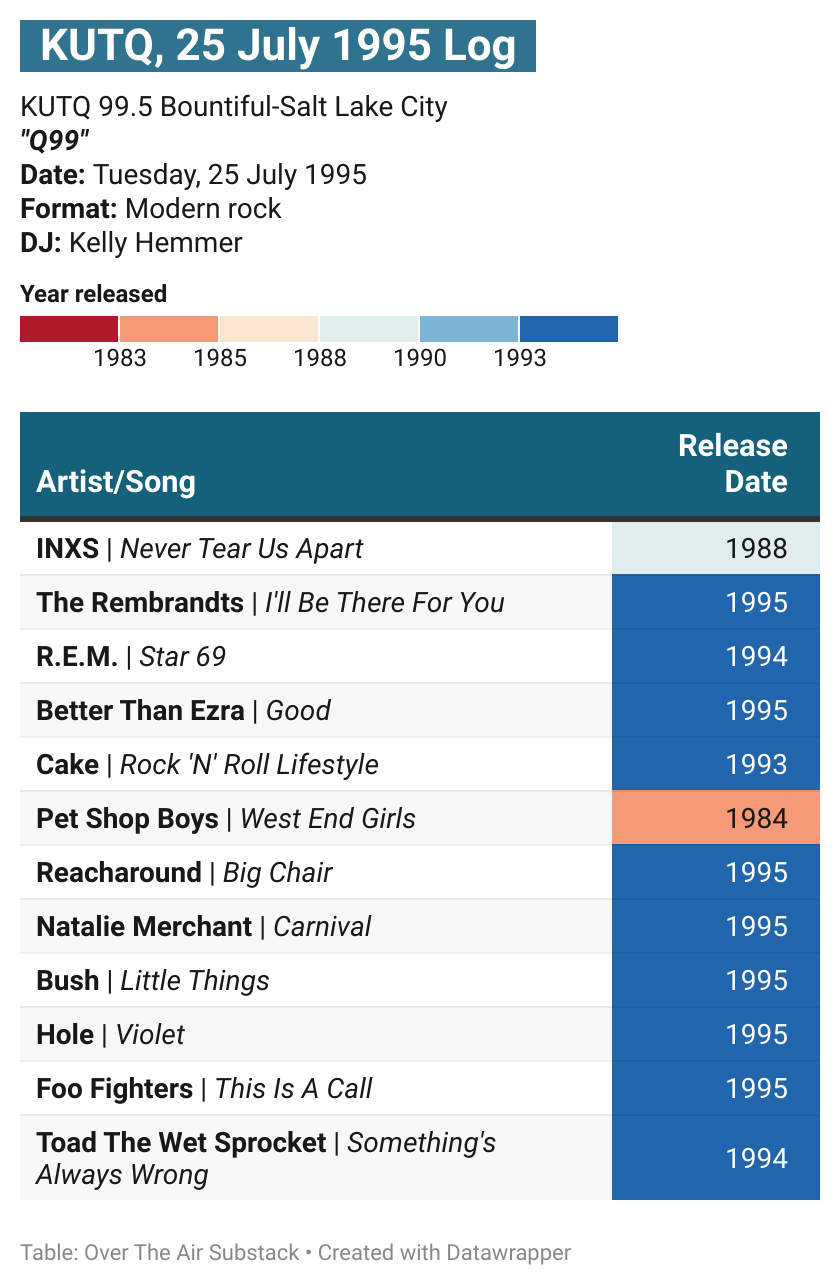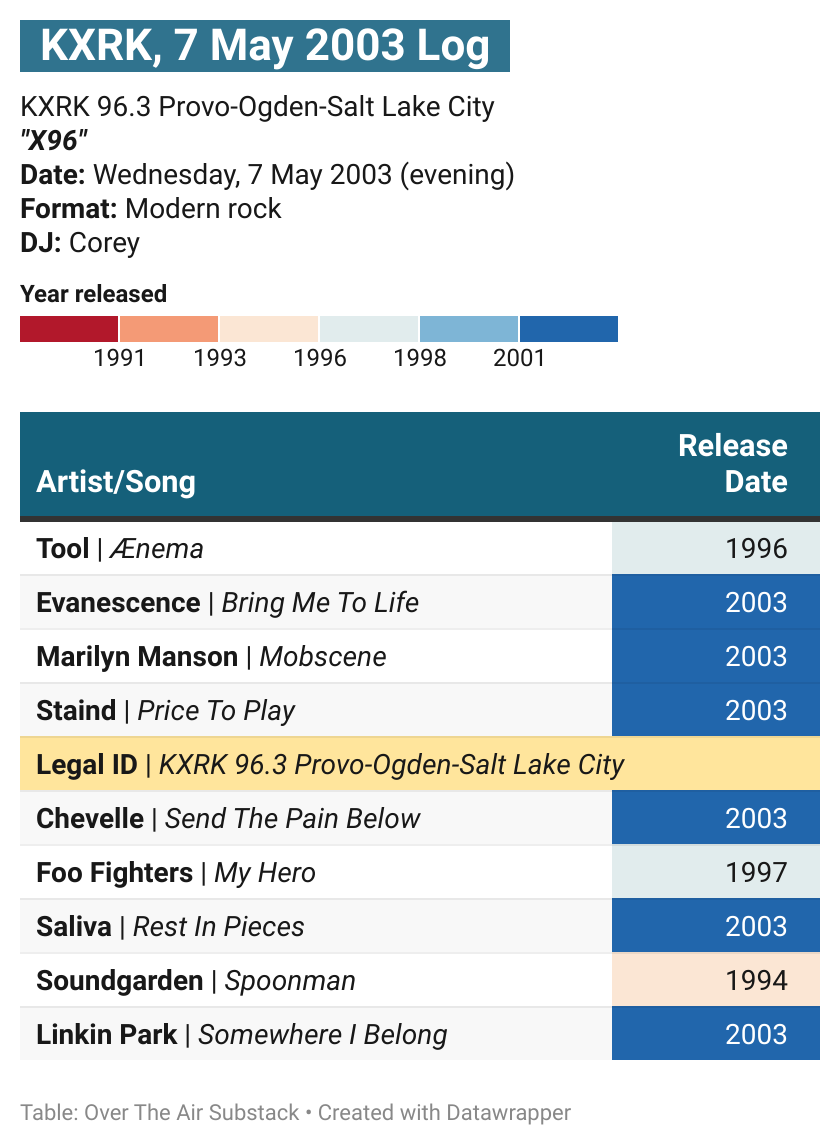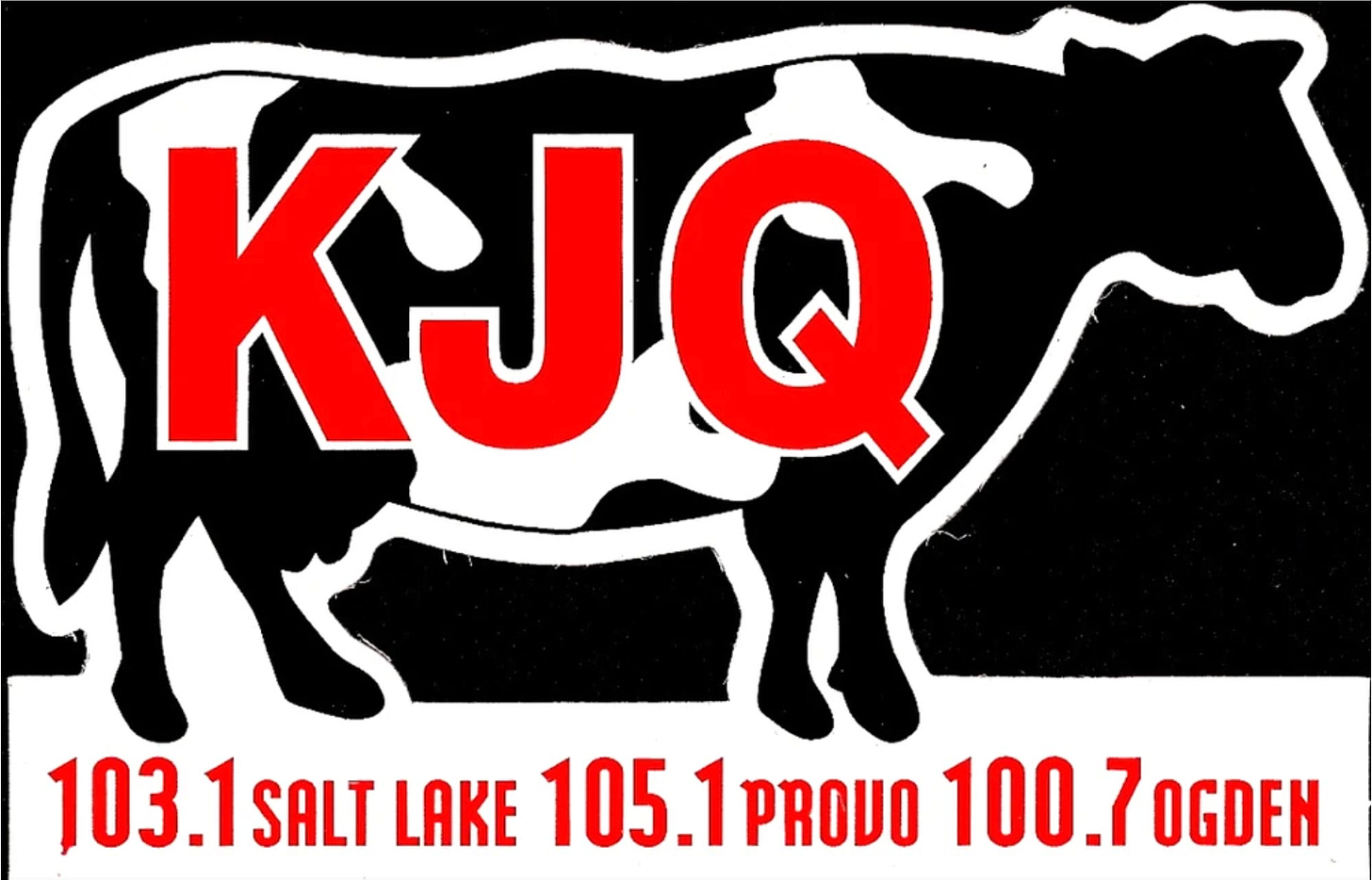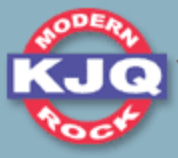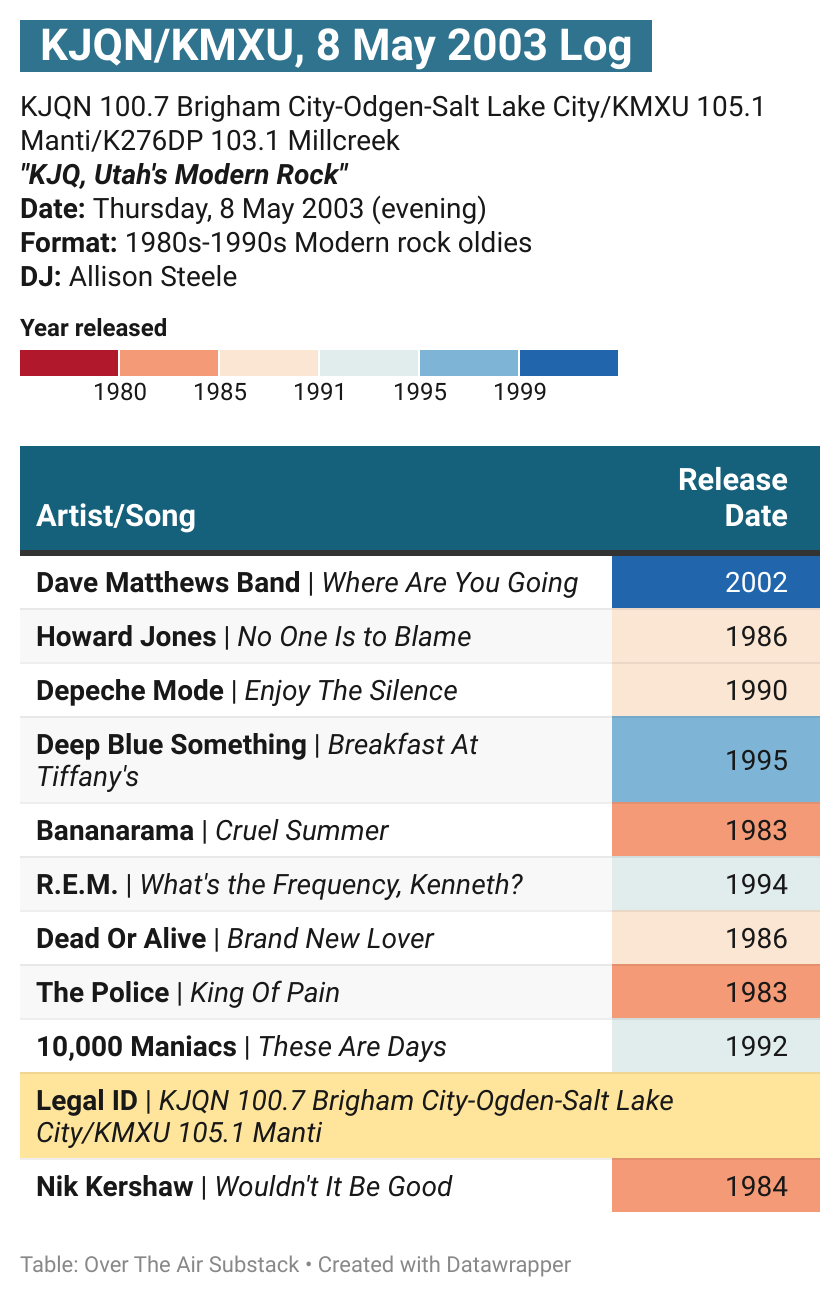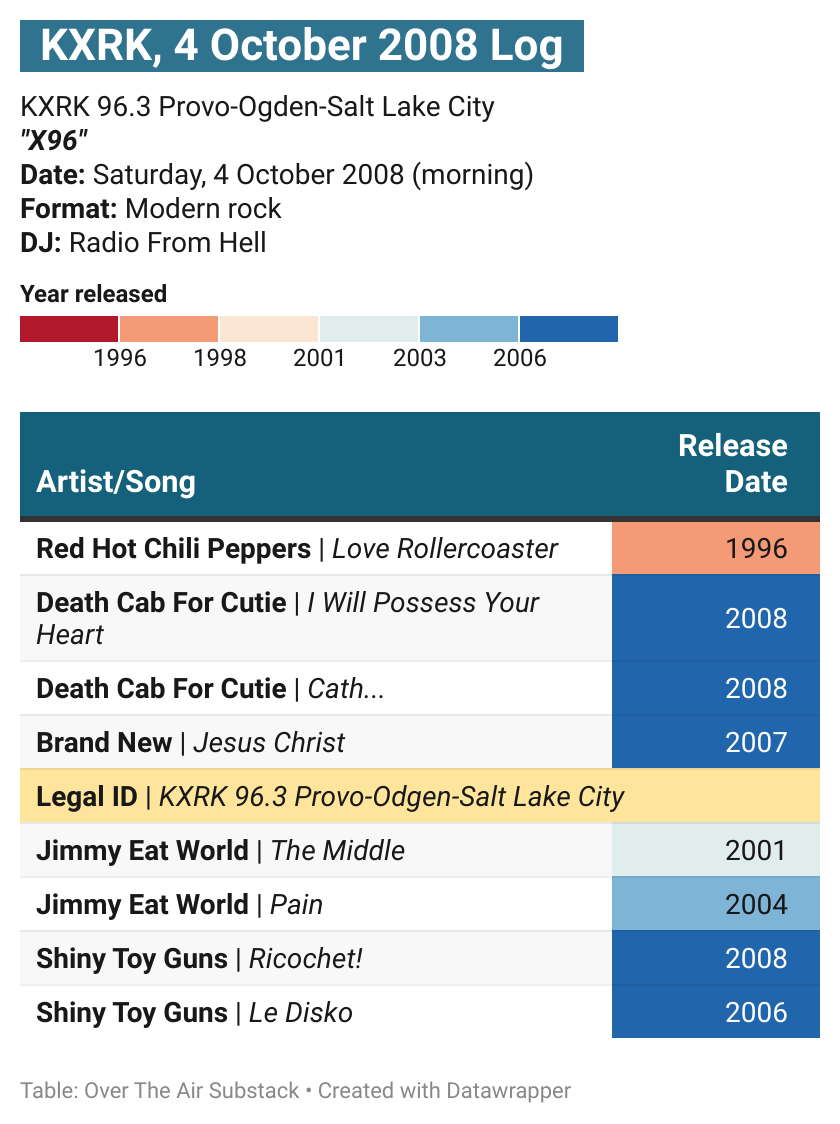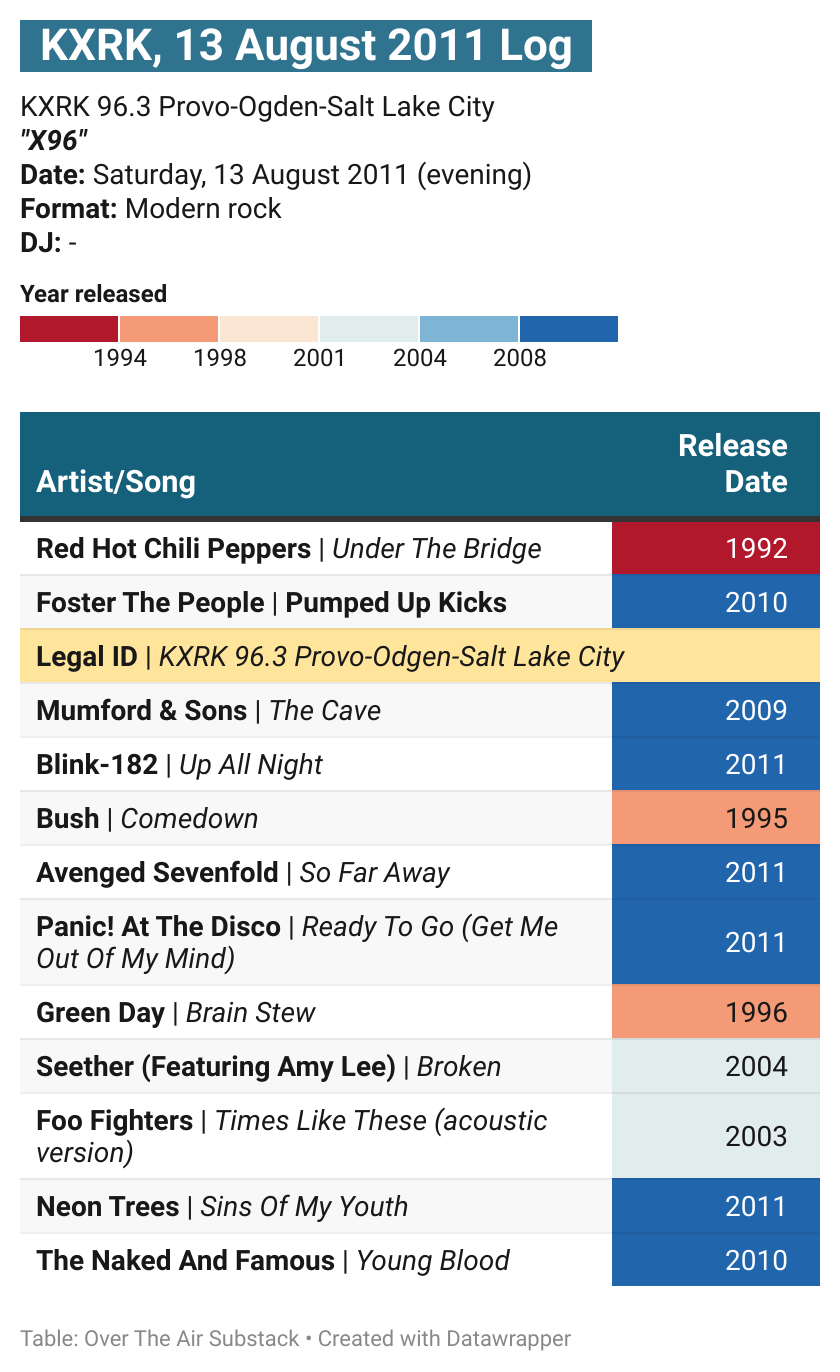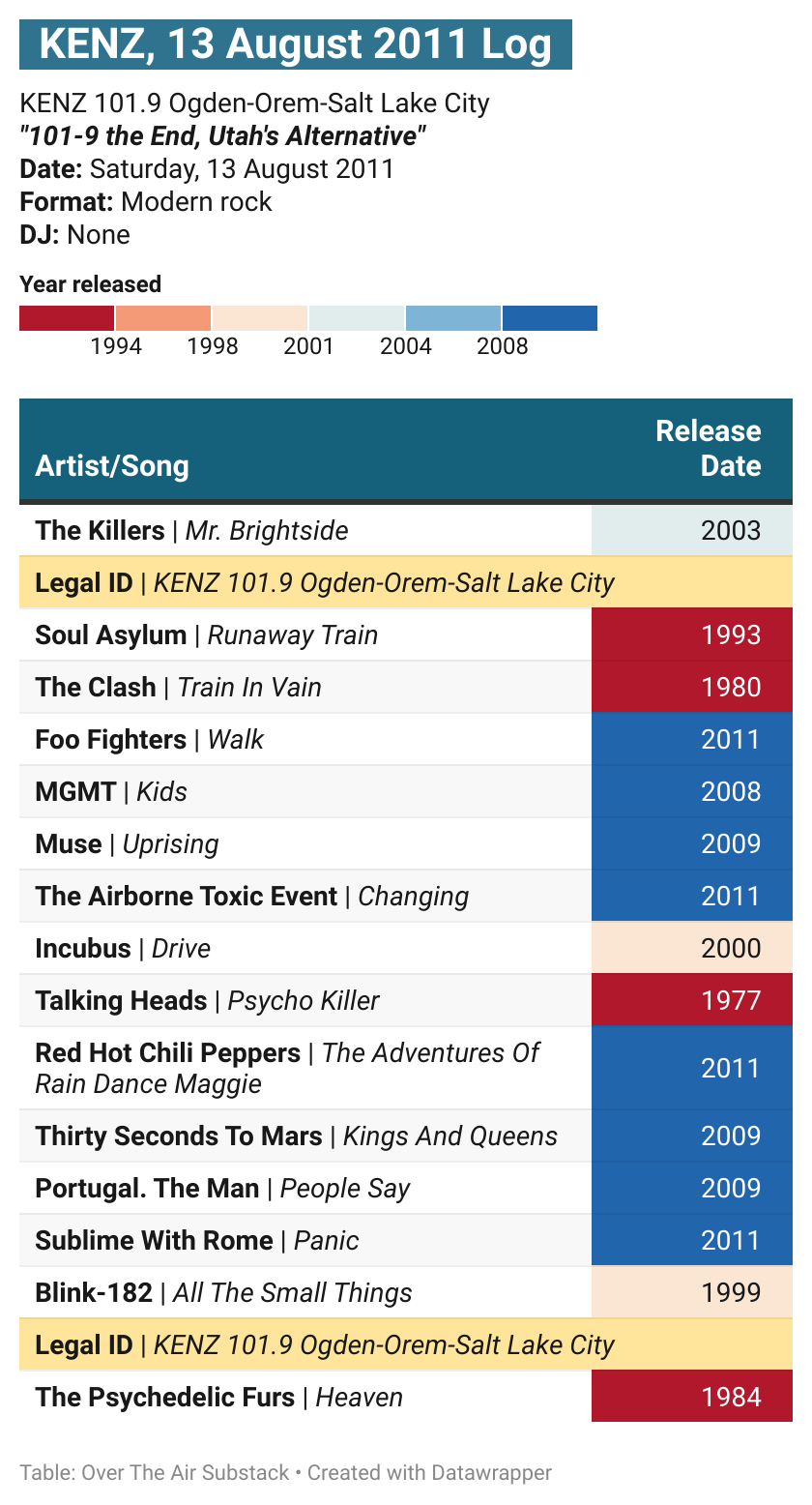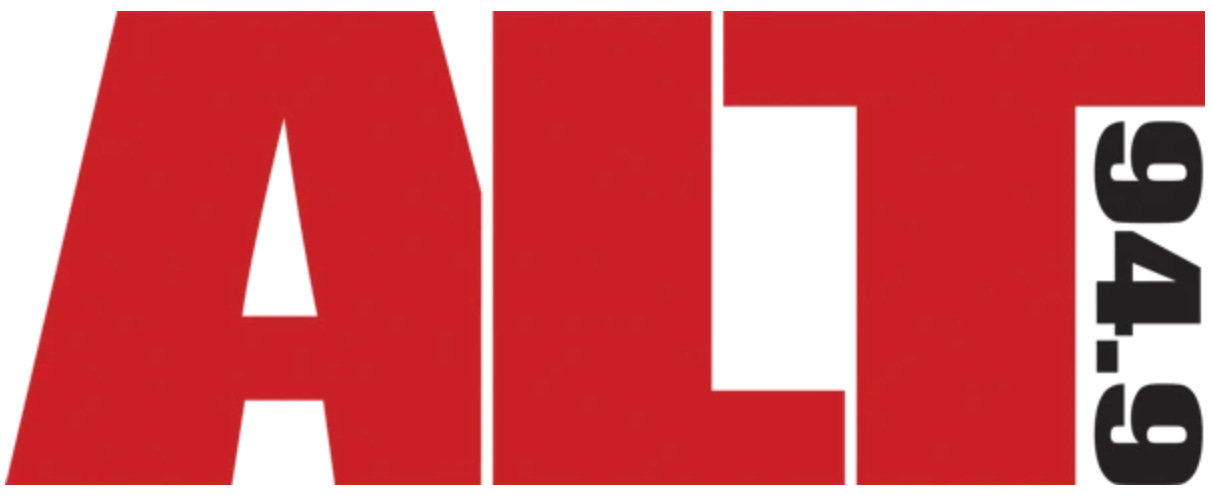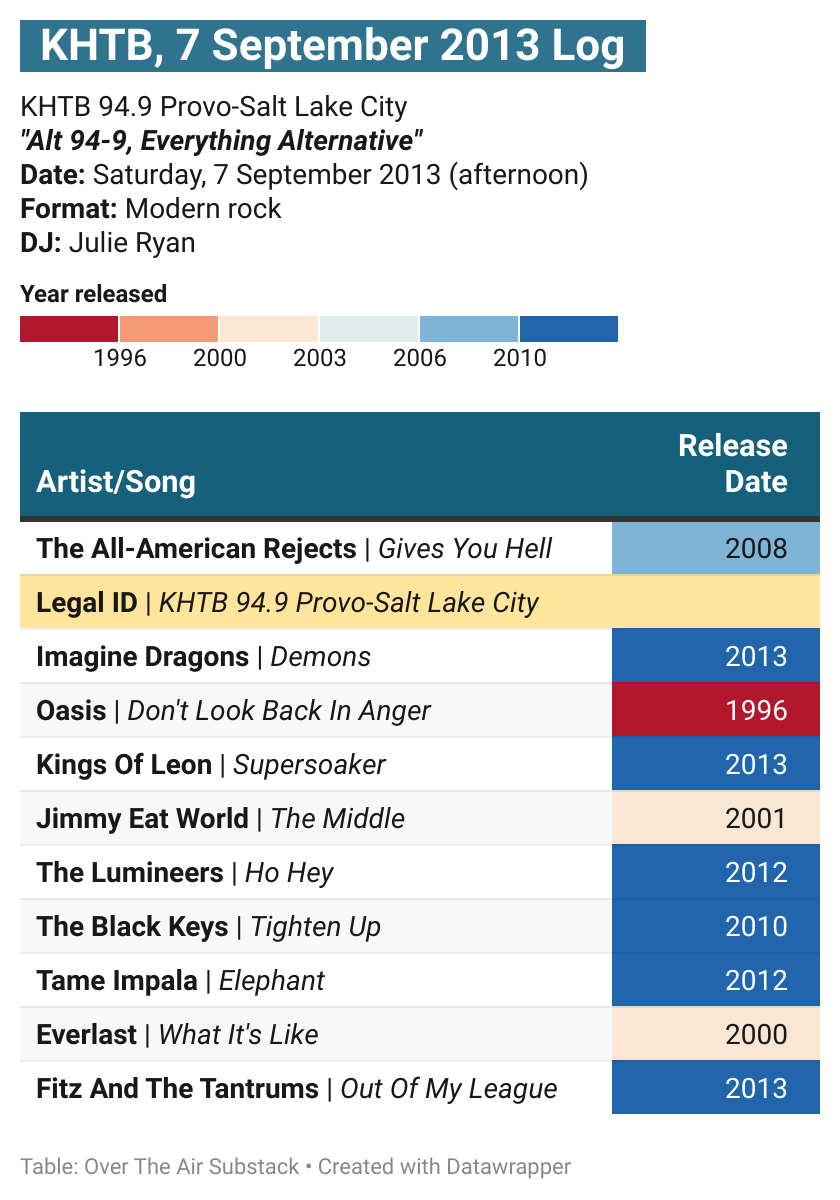Through The Years: Salt Lake City Modern Rockers
How the format evolved through the years: 1988 (KJQN-FM), 1995 (KXRK, KUTQ), 2003 (KXRK, KJQN/KMXU), 2008 (KXRK), 2011 (KXRK, KENZ), 2013 (KHTB), 2014 (KHTB), 2017 (KSQN)
For a change of pace this week, we will explore the evolution of one format in the same market over the years. In this piece, we will explore the evolution of modern rock in Salt Lake City. Read and listen along as we journey through the past couple of decades…
The top-grossing movie in 1988 was “Rain Man,” and George Michael’s “Faith” topped the Billboard’s year-end pop chart. In the Salt Lake City radio market, 1988 saw several significant changes: KSL 1160 dropped its remaining music blocks in September to become a full-time news/talk station, easy-listening KDAB 101.1 shifted to new age/smooth jazz, top 40 KFMY 96.1 flipped to oldies as KZOL “Oldies 96,” and country KRGO 1550 became KZQQ, joining Satellite Music Network’s Z-Rock hard rock network on New Year’s Day.
KJQN-FM 95.5/K224BY 92.7
In the ever-evolving landscape of radio, not every station leaves a lasting mark, particularly if their time on air is relatively brief. KJQN-FM, branded as "KJQ," helped pioneer modern rock radio in the Salt Lake City market and, despite its eventual demise, left a legacy that saw the brand resurrected later on.
Top 40 KJQN-FM first dipped its toes into the modern rock genre in March 1988, dedicating weeknights from 7 PM to 2 AM and weekends from 7 PM to 3 AM to the burgeoning format1 and moved to a full-time modern rock format on Monday, 23 May 19882.
Before KJQN-FM's arrival, the modern rock format was available for part of the market by suburban station KCGL 105.5, now talk station KNRS-FM 105.9. However, KCGL's run was cut short in October 1986 when it was sold and converted to a religious format,3 leaving a void for the format until KJQN-FM.
As a rimshot from Ogden, KJQN-FM used translator K224BY 92.7 Centerville to cover the city of Salt Lake City proper, so it referenced both the 92.7 and 95.5 signals on air.
KJQN-FM’s run was not without some drama. The station had a mass employee walkout in November 1991 with only 5 of the 25 employees remaining.4 Some of them began leasing rimshot top 40 KZOL 96.1 in February, transforming it to modern rock “X96,” with the KXRK calls coming mid-March. The emergence of a new competitor with most of its former staff took its toll on KJQN-FM, which flipped to top 40 KKBE “the Killer B” in October 1992. It was short-lived; KKBE flipped to southern gospel the following spring. Ultimately, the station was sold to the Bible Broadcasting Network in 1994, becoming KYFO-FM. To this day, KYFO-FM continues to broadcast BBN's network programming in the market. The original translator, K244BY, also moved frequencies and is now K217FQ at 91.3.
During its run, KJQN-FM introduced a station vehicle — the “milk beast” — that was a 1960s-era Ford milk truck painted like a cow named “Bessie.” It traveled around the market six days a week for promotions and charitable events, becoming another beloved part of the station.
This aircheck from June 1988 is a few weeks into KJQN-FM’s modern rock run.
Audio
Aircheck Log
"Toy Story" was the top-grossing movie of 1995, while Coolio's "Gangsta's Paradise" was Billboard's #1 pop song for the year. On the Salt Lake City radio dial, classic rock KLZX 93.3 “Z93” switched to country as KUBL “The Bull” in May. Its sister station, hot AC KVRI “Variety 98.7,” underwent a relaunch, emerging as KBEE “B98.7.”
KXRK 96.1
The first of several KXRK airchecks comes from this week in 1995. At this point, KXRK was still on its previous 96.1 facility. It was granted approval to move to 96.3 and improve its signal over the metro that summer and flipped the switch on the new 96.3 signal mid-December 1995.5
Audio
Aircheck Log
KUTQ 99.5
In late 1994, CHR station KUTQ “Q99” began evolving its format, initially adopting a CHR/modern rock hybrid. By this week in 1995, as heard in this aircheck, the station had fully committed to modern rock. This shift briefly created a scenario where the market once again hosted two competing modern rock outlets. However, this competitive landscape was short-lived, as KUTQ subsequently flipped to classic rock, becoming KURR, in 1996.
Audio
Aircheck Log
On the silver screen, “The Lord of the Rings: The Return of the King” reigned as the year's top-grossing movie, while 50 Cent's “In Da Club” was Billboard's #1 pop song of the year.
The Salt Lake radio landscape had a few notable changes. The talk format of KALL shifted from its 910 AM frequency to the stronger 700 AM signal, previously home to classic country KWLW. Meanwhile, Disney acquired the former 910 AM frequency, transforming it into Radio Disney affiliate KWDZ—though that station eventually ceased operations when its license was surrendered in 2017.
On the FM dial, the CHR “94-9ZHT” format and KZHT calls migrated from 94.9 FM to the more powerful signal of hot AC KISN-FM 97.1, rebranding itself as “97-1ZHT.” KEGA 101.5 switched to a country format, becoming “101.5 the Eagle."
KXRK 96.3
Audio
Aircheck Log
KJQN 100.7/KMXU 105.1/K276DP 103.1
In 2002, the familiar KJQN call letters were resurrected for a new Salt Lake City rimshot signal on 100.7, which launched with a classic alternative format. Echoing its 95.5 predecessor, this new KJQN utilized a translator, K276DP 103.1, to ensure city coverage. Furthermore, to reach the Provo area and southern market fringes, it simulcast on KMXU 105.1 Manti.
However, the classic modern rock sound proved short-lived; KJQN transitioned to country just two years later in 2004. Following a series of subsequent format changes, the station now operates as adult hits KYMV “Bob FM,” with city coverage facilitated by K288GY 105.5 Tooele. The original translator, K276DP, is no longer on air, having been supplanted by a new 103.1 signal—the Coalville-licensed station that also adopted the KJQN calls in December 2004. Meanwhile, the 105.1 signal underwent re-engineering to move in-market and is currently top 40 KUDD “Mix 105-1.”
Aside from the “KJQ” branding, this new KJQN also brought back “Bessie.” A nod to it is heard at the start of the aircheck with the “moo” in the background in the first imaging.
Audio
Aircheck Log
In 2008, “The Dark Knight” topped the box office as the year's highest-grossing film, while Flo Rida's “Low” dominated the music charts as Billboard's #1 pop song.
Meanwhile, the Salt Lake City radio scene saw some shifts. Contemporary Christian station KAOY 97.5 “97.5 the Oasis” transitioned to active rock, rebranding as KZZQ “97.5 the Blaze.” “The Blaze” moved to 97.5 after vacating its previous spot on KHTB 94.9, which then relaunched as “94-9 Z-Rock.”
KXRK 96.3
This aircheck from 2008 is a Saturday morning block that ran best-of material from KXRK’s “Radio From Hell” morning show. It also happened to be running a weekend playlist featuring two songs from the same artist.
Audio
Aircheck Log
In 2011, “Harry Potter and the Deathly Hallows - Part 2” cast its spell as the year's top-grossing movie, while Adele's “Rolling in the Deep” became Billboard's #1 pop song of the year.
On the local Salt Lake radio dial: In September, rhythmic AC KYMV 100.7 “Movin’ 100.7” transformed its sound, rebranding as “Rewind 100.7, Feel Good 80s And More.” Earlier in July, rock station KZZQ “97.5 the Blaze” changed formats entirely, becoming KZNS-FM, “the Zone,” moving the FM simulcast of sports KZNS 1280 from KZNS-FM 104.7, which itself became regional Mexican KNIV. Also, in 2011, country KSOP-FM 104.3 rebranded from “the Cowboy 104.3” to “Z104.”
KXRK 96.3
Audio
Aircheck Log
KENZ 101.9
On New Year's Day 1996, AC KMXB 107.5 flipped its format to AAA KENZ “107.5 The End.” In 2005, the KENZ call letters and alternative format moved to the stronger 101.9 FM signal, displacing country station KKAT. Despite the new frequency, the established “The End” branding also transitioned to 101.9.
“The End” came to an end in April 2010 when KENZ flipped to GenX/1990s hits “101.9 Utah.” This venture was short-lived, lasting only eight months. By December 2010, KENZ had flipped back to the “101-9 the End” branding, but with a focus on modern rock,6, which is the era this aircheck comes from.
Today, the KENZ call letters reside on its sister station at 94.9 FM. The 101.9 frequency is now KHTB, which simulcasts with 94.9 as top 40 “Power 94.9/101.9.”
Audio
Aircheck Log
The top grossing movie in 2013 was “The Hunger Games: Catching Fire.” Billboard’s #1 pop song of the year was Macklemore & Ryan Lewis’ “Thrift Shop.” In local radio, the “101.9 the End” ended yet again on KENZ 101.9 as it flipped to classic hits “Classic Hits 101.9” in August.
KHTB 94.9
Just five days before this aircheck, rock station KHTB “94-9 Z-Rock” shifted into modern rock “Alt 94-9.” This “Alt” format later moved to sister station KENZ 101.9 in 2015, leading to a call sign swap: 94.9 became KENZ, and 101.9 became KHTB.
KENZ 94.9 had a brief stint as classic hip hop “94-9 The Vibe” before flipping to CHR “Power 94-9” in 2017. Then, in 2019, KHTB dropped “Alt 101-9” and began simulcasting the “Power” CHR format. Both stations continue this simulcast today.
Audio
Aircheck Log
The top grossing movie in 2014 was “American Sniper.” Billboard’s #1 pop song of the year was Pharrell Williams’ “Happy.” Scanning the dial: KLO-FM 103.1 dropped its talk simulcast with sister KLO 1430 to become AC KSQN “Sunny 103.” The short-lived classic hits format on KENZ 101.9 “Classic Hits 101.9” shifted to adult hits “Trax 101.9.”
KHTB 94.9
I previously put up a 13 January 2014 aircheck of “Alt 94-9” — click the link for that post.
In 2017, pop culture was dominated by familiar names. “Star Wars: Episode VIII - The Last Jedi” was the year's top-grossing movie, while Ed Sheeran's “Shape Of You” took the #1 song of the year on Billboard's pop chart.
The local Salt Lake City radio scene saw a listener uprising involving BYU. The university initially announced plans to flip its classical station, KBYU-FM 89.1, to carry BYU Radio talk programming. However, listener outcry led to a different outcome: BYU instead purchased AAA KUMT 107.9 “107.9 The Mountain” and converted that frequency to BYU Radio, allowing KBYU-FM to remain an all-classical station.
KSQN 103.1
In September 2016, AC KSQN “Sunny 103” flipped to 80s-based classic modern rock “103-1 the Wave, the Next Wave of New Wave.”
This aircheck comes from the following spring. KSQN offered a remarkably deep dive into 80s alternative and new wave. Its playlist featured tracks fairly obscure on radio, even compared with Sirius XM's First Wave channel, which covers the same period.
In November 2020, the station changed its calls back to KLO-FM, an exceptionally rare shift to a three-letter call sign. This unusual move was facilitated by an FCC loophole allowing an FM station to assume the calls of a co-owned station in a different band but in the same market. KLO 1430, KSQN's sister station, had held its three-letter calls, grandfathered since 1929. When KLO 1430 was set to be spun off and its call sign wasn't part of the sale, KSQN adopted the KLO-FM calls while both stations were still under shared ownership, effectively preserving a piece of radio history. Today, the former KLO 1430 broadcasts as Spanish Catholic KMES, while KLO-FM remains "103-1 The Wave," playing classic alternative.
Audio
Aircheck Log
As always, the logos and other intellectual property belong to the stations. The recordings were made from over the air broadcasts. Similarly, other data (charts, ratings, etc.) belong to their respective owners.
“Radio Format Moves Again To FM Station,” The Salt Lake Tribune, 4 March 1988.
“KJQ Goes Modern; Summers Becomes PD,” Radio & Records, 27 May 1988.
“KCGL Format Change Follows Sale,” Radio & Records, 10 October 1986.
“Radio Waves,” The Salt Lake Tribune, 20 December 1991.
“Street Talk,” Radio & Records, 15 December 1995.
“101.9 The End Returns In Salt Lake City,” RadioInsight.com, 21 December 2010.



